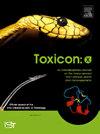Stress levels, hematological condition, and productivity of plasma-producing horses used for snake antivenom manufacture: A comparison of two industrial bleeding methods
IF 2.8
Q2 TOXICOLOGY
引用次数: 0
Abstract
The immunization and industrial bleeding of horses are essential stages for producing snake antivenoms. In Costa Rica, the traditional method involves stimulating the antibody response of horses by periodically injecting venoms, collecting hyperimmune plasma over three consecutive bleeding days, and repeating this process every eight weeks. While this method does not cause major physical or hematological issues in horses, the associated stress has not been evaluated. We compared this traditional method with an alternative method that involves injecting venoms, collecting hyperimmune plasma in a single bleeding day, and repeating the process every two weeks. We assessed stress (via serum and fecal cortisol levels and an ethological study), hematological parameters (hematocrit and hemoglobin concentration), and plasma productivity over eight months. Serum cortisol levels remained within the normal range for both methods throughout the immunization/bleeding cycle. However, serum and fecal cortisol levels were significantly higher in horses subjected to the traditional method compared to those in the alternative method. Neither method caused significant hematological alterations. Notably, the alternative method yielded a higher volume of plasma. We concluded that adopting the alternative method ensures horse welfare while improving industrial bleeding productivity. This approach may reduce costs and improve the availability of this essential treatment for vulnerable populations.

用于制造蛇毒血清的产血马的应激水平、血液状况和生产率:两种工业化放血方法的比较
对马进行免疫和工业化放血是生产蛇类抗蛇毒血清的重要阶段。在哥斯达黎加,传统方法是通过定期注射毒液来刺激马匹的抗体反应,在连续三个放血日内收集高免疫血浆,并每八周重复这一过程。虽然这种方法不会对马的身体或血液造成大的影响,但相关的压力尚未得到评估。我们将这种传统方法与另一种方法进行了比较,后者包括注射毒液,在一个出血日内收集高免疫血浆,并每两周重复一次。我们评估了八个月内的压力(通过血清和粪便皮质醇水平以及伦理研究)、血液学参数(血细胞比容和血红蛋白浓度)以及血浆生产率。在整个免疫/放血周期中,两种方法的血清皮质醇水平都保持在正常范围内。然而,采用传统方法的马匹血清和粪便皮质醇水平明显高于采用替代方法的马匹。两种方法都没有引起明显的血液学变化。值得注意的是,替代方法产生的血浆量更高。我们的结论是,采用替代方法既能确保马匹的福利,又能提高工业出血的生产率。这种方法可以降低成本,改善弱势人群获得这种基本治疗的机会。
本文章由计算机程序翻译,如有差异,请以英文原文为准。
求助全文
约1分钟内获得全文
求助全文
来源期刊

Toxicon: X
Pharmacology, Toxicology and Pharmaceutics-Toxicology
CiteScore
6.50
自引率
0.00%
发文量
33
审稿时长
14 weeks
 求助内容:
求助内容: 应助结果提醒方式:
应助结果提醒方式:


